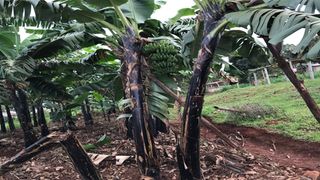
Farming
Prime
Maximise profits from banana this season
What you need to know:
- For ease of implementing agronomic practices, Dr Ssetumba Mukasa remarks that bananas should be planted in rows. The recommended spacing between plants is three metres between the planting rows and three metres within or wider, depending on the soil fertility.
Uganda has the highest average annual banana consumption in the world. Many families use bananas for food security purposes as well as income-generating. Bananas also provide soil surface cover, are environment friendly, a good source of mulch: maintaining and improving soil fertility and provide animal feed.
Varieties
There are several groups and varieties of bananas. They are grouped according to genome, agro-ecology and use. It is also important that you choose the varieties that suit the local conditions, high yielding and with market traits, says Dr Ssetumba Mukasa, an agronomist, at the School of Agricultural Sciences, Makerere University.
Varieties include; the East African highland bananas for instance are indigenous to East Africa and are placed in two groups (Nkago and Mbidde) and five clone sets such as kisansa, nfuuka, nakitebe, nakabululu and mbidde. Cavendish bananas include Gros Michel, Williams, Valery and Grand naine. Apple bananas (sukaalindiizi) and plantains among others.
Site selection
According to Dr Ssetumba, choosing a site for growing bananas must be well thought out because bananas need deep well-drained loam soil with high humus content, and with considerable amounts of nutrients.
“High rainfall or good supply of water all year round, and temperatures of 20 – 30°C. Note that very acidic soils are not suitable and the site should be free of perennial weeds such as couch grass. If the site is sloping, appropriate soil conservation structures are needed,” he says adding that, “Land chosen must be protected from strong wind, animals and thieves. The plantation should be close to a road, for easy transport of the produce, inputs and planting material.”
Land preparation
Andrew Twesigye, a banana grower in Sheema District remarks that bananas can be planted on fallow land (after one to three years) or in newly established fields. The newly established fields (bush) should be cleared and any debris removed or burned. “If fallow land is used, the vegetation should be cleared without burning, as burning destroys useful organic matter. Clearing is essential for easy marking of planting fields, habitats for pests are destroyed and deep ploughing helps to break loose the soil,” says Twesigye.
A few days after cutting the vegetation, the remaining grass may be sprayed with herbicides to speed up organic matter breakdown.
Planting
For ease of implementing agronomic practices, Dr Ssetumba remarks that bananas should be planted in rows. The recommended spacing between plants is three metres between the planting rows and three metres within the or wider, depending on the soil fertility.
“Rows should be straight to give plants the maximum amount of sunlight. On sloping land, the rows should follow the contour lines in order to decrease soil erosion,” he says.
Intercropping increases plant spacing, and 6 × 6 m is often used. The most common planting hole size is 45 × 45 × 45 cm. When preparing the planting holes; the topsoil, which contains humus, should be separated from the sub-soil during the process of digging the planting hole.
Organic manure such as cow dung or chicken droppings should be mixed in equal quantities with the topsoil dug from the hole and the manure/soil mixture placed in the planting hole.
He says, “Do not fill the planting hole to the top. Leave some space for collecting rainwater around the growing sucker. If manure is very fresh, then planting should be delayed for six to eight weeks to avoid damaging the plants (through heat production during fermentation of the manure).”
If manure is well dried, planting can be carried out on the same day. Planting should occur at the onset of the rainy season or the suckers will need supplemental watering (with mulch around).
Plant nutrition
As a plant grows, it takes up nutrients from the soil. A lot of the nutrients taken up by a banana plant go into the fruits (bunch). With time, the nutrients become depleted and the only way to maintain soil fertility is by regularly putting back nutrients into the soil in the form of fertilisers. If fertility is not maintained in this way, even the most fertile soils will gradually become unproductive.
Bananas have a high demand for nitrogen and potassium. Other minerals that are vital for banana production, though in small quantities, include phosphorus, magnesium and calcium.
The money
With the spacing of (3x3m) you will have about 450 plants per acre. If a sucker costs Shs2,000, you will need Shs900,000 to secure the suckers for one acre. The labour costs for ploughing (Shs500,000), digging holes and planting (Shs350,0000), weeding, pruning and manure application (Shs250,000) fertiliser, manure and their application (Shs950,000), herbicides (Shs200,000), mulch and mulching (Shs500,000) these give a total of Shs3,650,000. Please note that these estimated figures can change depending on the site.
Your banana plants will start fruiting after about 12 months and from your acre, you will harvest 450 bunches. The average cost of a bunch of banana is Shs15,000 and this will yield you Shs6,750,000. Remember that the number of yields increase in the subsequent years.
Advice
In order for you to have a successful banana farming business, Twesigye advises that it is important that you develop a culture of record keeping and a benefit–cost analysis.
Don’t want to miss out on any story? For updates on all Monitor stories, follow this link on Telegram: https://t.me/dailymonitor




